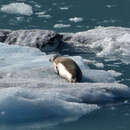Biology
provided by Arkive
This species is gregarious; on land it forms groups to breed, rest and moult that are generally small but may number up to 1,000 individuals (5). Common seals feed mainly on a variety of fish, but squids, whelks, crabs and mussels are also taken. Juveniles feed on shrimps before progressing to the adult diet (2). When feeding, common seals travel up to 50 kilometres from haul-out sites to feed and may stay out at sea for days. They can dive for up to 10 minutes, and reach depths of 50 metres or more (3).
With regards to breeding, there is apparently no social organisation, but females often give birth in small groups (7). Females give birth to a single pup at the end of June to early July (8). The pups weigh 11 to 12 kilograms at birth and are able to swim and crawl almost immediately (2). Pups are nursed for about four weeks, after which they may disperse over long distances (5). Around the time that the pup is weaned, females become receptive and copulation occurs. Males frequently engage in underwater displays and fights around this time and can lose up to 25 percent of their body weight (5).
Conservation
provided by Arkive
A number of key UK pupping and haul-out sites have been suggested as candidate Special Areas of Conservation (9). It has been recommended that human access to breeding sites could be restricted to reduce disturbance. Guidance notes on monitoring techniques for this species have been produced by the Joint Nature Conservation Committee, the Government's wildlife advisor (9).
Description
provided by Arkive
Also known as the harbour seal, the common seal is the smaller of the two breeding seals in Great Britain (6). When hauled out it often adopts a characteristic 'head-up, tail-up' posture. The colour is variable, ranging from black-grey to sandy brown with many small spots. The top of the small head is round and the nostrils form a 'V' (2). Males are often darker in colour than females and have a heavier appearance. The white natal coat of the young is shed inside the uterus; pups are therefore born with their first adult coat (2).
Habitat
provided by Arkive
Common seals seem to prefer sheltered waters. They haul out on a range of habitats such as rocky shores, sand and gravel beaches, mudflats and sand bars. Preferred haul out sites are protected against land predators and strong winds or waves, are close to food sources and enable direct access to deep water (5).
Range
provided by Arkive
The common seal is found from the subtropics to the Arctic around coasts of the North Atlantic and the North Pacific (6). In Europe they occur off Icelandic, Danish, German, Dutch and Icelandic coasts as well as around the UK. The UK supports 45 percent of the European population (five percent of the world population); main centres of population occur in the Moray Firth, The Wash and the Tay Estuary, and the species is fairly widespread around west Scotland, the Northern Isles and the Hebrides (6).
Status
provided by Arkive
Classified as Least Concern (LC) on the IUCN Red List (1). Protected in Britain under the Conservation of Seals Act 1970 (closed season from 1 September until 31st December) (3) and schedule 3 of the Conservation Regulations (1994) (4). Listed as a protected species under Annex II and Annex V of the European Community's Habitats Directive. The eastern Atlantic population is listed under Appendix III of the Bern Convention. Subpopulations in the Baltic and Wadden Seas are listed under Appendix II of the Bonn Convention (5).
Threats
provided by Arkive
The population of common seals in the UK cannot be estimated very accurately but humans have historically hunted the common seal in great numbers. The Seal Conservation Act of 1970 gives a degree of protection as shooting is outlawed during the breeding season, however if a seal is deemed to be interfering with fishing nets, it can legally be shot at any time under the 'Fisheries Defence Clause' (5). In 1988 a disease caused by the newly emerged phocine distemper virus killed about 3,000 of the UK's common seals. Such drastic population crashes seem to be a natural occurrence, and little can be done to prevent them (3). Common seals are also susceptible to oil and chemical pollutants (3).

